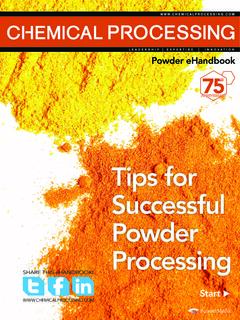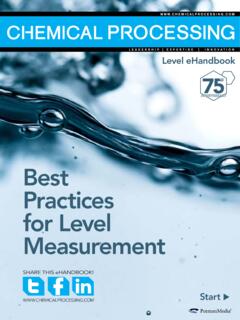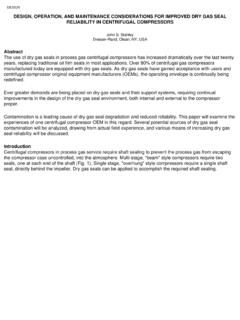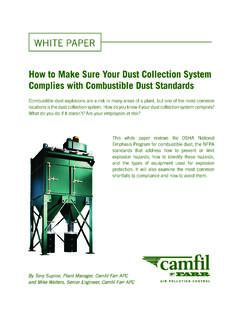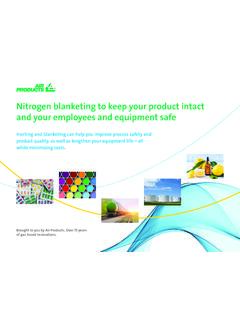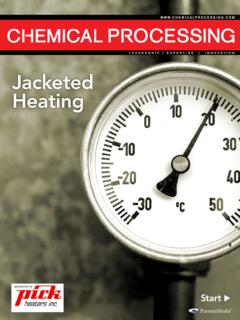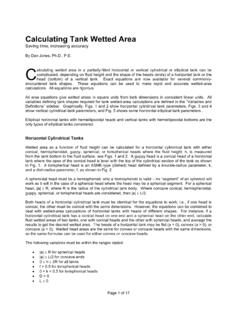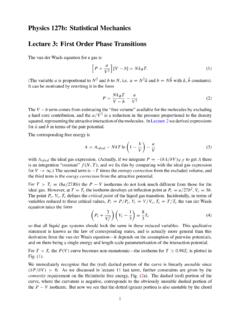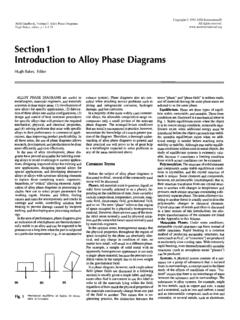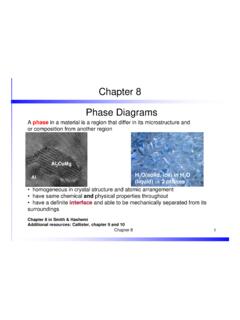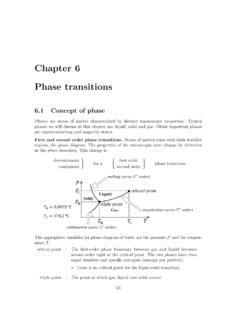Transcription of PROCESS MODELLING SELECTION OF THERMODYNAMIC …
1 PROCESS MODELLING . SELECTION OF. THERMODYNAMIC METHODS. by John E. Edwards Download available from P & I Design Ltd MNL031 05/01. 2 Reed Street, Thornaby, UK, TS17 7AF Page 1 of 15. Tel: 00 44 (1642) 617444. Fax: 00 44 (1642) 616447. PROCESS MODELLING SELECTION of THERMODYNAMIC Methods Contents Introduction THERMODYNAMIC Fundamentals THERMODYNAMIC Energies gibbs Phase Rule Enthalpy System phases Single Phase Gas Liquid Phase Vapour liquid equilibrium Summary Appendices I Enthalpy Calculation in CHEMCAD. II THERMODYNAMIC Model SELECTION Vapour Liquid Equilibrium Figures 1 Ideal Solution Txy Diagram 2 Enthalpy Isobar 3 THERMODYNAMIC phases 4 van der Waals Equation of State 5 Relative Volatility in VLE Diagram 6 Azeotrope Value in VLE Diagram 7 VLE Diagram and Convergence Effects 8 Chemcad K and H Values Wizard 9 THERMODYNAMIC Model Decision Tree 10 K Value and Enthalpy Models SELECTION Basis References 1.
2 Coffin, , 584-588 (1946), A Presentation of the THERMODYNAMIC Functions . 2. Felder and Rousseau, Elementary Principles of Chemical Processes , 2nd Edition, John Wiley and Sons. 3. Reid, Prausnitz, Poling, The Properties of Gases and Liquids , 4th Edition, McGraw Hill. 4. I. Smallwood, Solvent Recovery Handbook , Edward Arnold, 1993. 5. , Chemical Engineers' Handbook , McGraw Hill. MNL031 05/01. Page 2 of 15. PROCESS MODELLING SELECTION of THERMODYNAMIC Methods INTRODUCTION. The SELECTION of a suitable THERMODYNAMIC model for the prediction of enthalpy (H) and phase equilibrium (K) is fundamental to PROCESS MODELLING . SELECTION of an inappropriate model will result in convergence problems and erroneous results. The SELECTION PROCESS is driven by considering the following:- PROCESS species and compositions. Pressure and temperature ranges. Phase systems involved. Nature of the fluids.
3 Availability of data. There are four categories of THERMODYNAMIC models:- Equations-of-State (E-o-S). Activity coefficient ( ). Empirical Special system specific This paper is not intended to be a rigorous analysis of the methods available and their SELECTION but is offered as an aide memoire to the practicing engineer who is looking for rapid, realistic results from his PROCESS models. The study of complex systems invariably involves extensive research and expenditure of considerable manpower effort by specialists. There are extensive sources of data available from data banks run by DECHEMA, DIPPR and others. This paper presents practical SELECTION methods and suggests techniques to test the validity of the THERMODYNAMIC model selected. MNL031 05/01. Page 3 of 15. PROCESS MODELLING SELECTION of THERMODYNAMIC Methods THERMODYNAMIC FUNDAMENTALS. THERMODYNAMIC Energies(1).
4 The THERMODYNAMIC fundamentals of fluid states in relation to energies and phase behaviour needs to be thoroughly understood. Four THERMODYNAMIC variables determine six THERMODYNAMIC energies Intensive variables Extensive variables (capacity). Pressure (P) Volume (V). Temperature (T) Entropy (S). We define THERMODYNAMIC energy as follows Energy = Intensity variable x Extensive variable P or T V or S. TS represents internal bound energy isothermally unavailable. PV represents external free energy. Helmholtz free energy (F) is the internal energy available for work and is part of the internal energy (U). We have the following energy relationships Internal energy U =T S +F. gibbs free energy G = F +P V. Enthalpy H = T S +F +P V. H =U +P V. When considering chemical reactions we have Chemical energy = chemical potential factor x capacity factor (. dU = i i dn i 0. ). Where dn i is change in species i moles i is chemical potential species i dU = T dS P dV + i dn i i For equilibrium i dn i = 0.
5 I Other equilibrium conditions dF = 0 (constV & T) dG = 0 (constP & T). dU = 0 (constS & V ) dH = 0 (constS & P). It can be shown that G = i ni i MNL031 05/01. Page 4 of 15. PROCESS MODELLING SELECTION of THERMODYNAMIC Methods gibbs Phase Rule (2). The variables that define a PROCESS condition are in two categories Extensive variables moles, mass, volume Intensive variables temperature, pressure, density, specific volume, mass and mole fractions of components i. The number of intensive variables that can be independently specified for a system at equilibrium is called the number of degrees of freedom F and is given by the gibbs Phase a system involving no reactions this is given by F = 2 + m p Where m = no of chemical species i p = number of system phases With r independent reactions at equilibrium F = 2 + m r p When defining a stream condition in the model the phase rule applies.
6 Consider a single component liquid in equilibrium with its vapour and an inert. Giving m = 2 p = 2 F = 2. Two variables P and T or Vapour fraction (v) with T or P will define the stream. For a binary liquid system one degree of freedom is consumed by the composition leaving either P or T to be a VLE system it is preferable to specify P which then allows system analysis using Txy plots. When setting up the FlashUnitOp applying the phase rule will ensure that relevant flash conditions are being set. The stream flash calculation can be used to determine the boiling point and dew point of mixtures with and without inerts present by applying the following. The bubble point of a liquid at the given pressure is determined by a flash calculation at a vapour fraction of 0. The dew point of a vapour at the given pressure is determined by a flash calculation at a vapour fraction of 1.
7 For a pure component the bubble point and the dew point are identical so a flash calculation at a vapour fraction of 0 or 1 will yield the same result Figure 1 shows the Txy diagram for Benzene/Toluene,a near ideal bubble point for a given composition is read directly from the liquid curve and the dew point is read directly from the vapour curve. MNL031 05/01. Page 5 of 15. PROCESS MODELLING SELECTION of THERMODYNAMIC Methods Enthalpy Enthalpy is the sum of the internal energy (U) and the external free energy (PV). H =U +P V. The heat supplied is given by dQ = dU + P dV. The sign convention should be noted and is + for heat added and dU gain in internal energy dU = Cv dT. The specific heat at constant pressure Cp is related to heat input dQ = Cp dT. The adiabatic index or specific ratio is defined Cp =. Cv It can be shown that the following relationship holds Cp Cv = R.
8 The heating of a liquid at constant pressure water is considered in Figure 2. This shows the relationships between the enthalpies in the different phases namely the sensible heat in the liquid phase, the latent heat of vaporisation during the vapour liquid equilibrium phase and the superheat in the gas phase. Enthalpy is calculated using Latent Heat (LATE) in the liquid and vle phases and E-o-S. (SRK) in the superheated or gas phase. Appendix I reviews the calculation methods adopted in CHEMCAD. A standard reference state of 298 K for the liquid heat of formation is used providing the advantage that the pressure has no influence on the liquid Cp The enthalpy method used will depend on the K-value method selected as detailed in Appendix II with the following exceptions Peng Robinson (PR) H value PR. Benedict-Webb-Ruben-Starling (BWRS) H value BWRS. Grayson Streed (GS) and ESSO H value Lee Kessler Amine H value Amine Special methods are used for Enthalpy of water steam tables (empirical).
9 Acid gas absorption by DEA and MEA. Solid components MNL031 05/01. Page 6 of 15. PROCESS MODELLING SELECTION of THERMODYNAMIC Methods SYSTEM phases . There are three phase states namely solid, liquid and gas. Processes comprise either single phase or multiphase systems with separation processes involving at least two phases . Processes involving solids such as filtration and crystallisation, solid liquid systems and drying, solid gas system are special cases and receive no further consideration here. The primary area of interest for THERMODYNAMIC model SELECTION involve two phases . Liquid liquid systems, such as extraction and extractive distillation, where liquid liquid equilibrium (LLE) is considered and vapour liquid systems, such as distillation, stripping and absorption, where vapour liquid equilibrium (VLE) is considered. Figure 3 shows the inter-relationships between the sys tem phases for a series of isotherms based on the E-o-S due to van-der-Waal.
10 This figure provides the first indication of the validity of making a THERMODYNAMIC model SELECTION for the K-value on the basis of the system phases namely single phase gas by E-o-S and VLE by activity coefficient. Single Phase Gas (2). An E-o-S relates the quantity and volume of gas to the temperature and pressure. The ideal gas law is the simplest E-o-S. P V =n R T. Where P = absolute pressure of gas V = volume or volume of rate of flow n = number of moles or molar flowrate R = gas constant in consistent units T = absolute temperature In an ideal gas mixture the individual components and the mixture as a whole behave in an ideal manner which yields for component i the following relationships P i V = ni R T. pi ni = = yi where yi is mole fraction of i in gas P n pi = y i P. pi = P where P is the total system pressure i i = 0i + R T ln pi Note that when pi = 1 we have i = 0i the reference condition As the system temperature decreases and the pressure increases deviations from the ideal gas E-o-S result.
